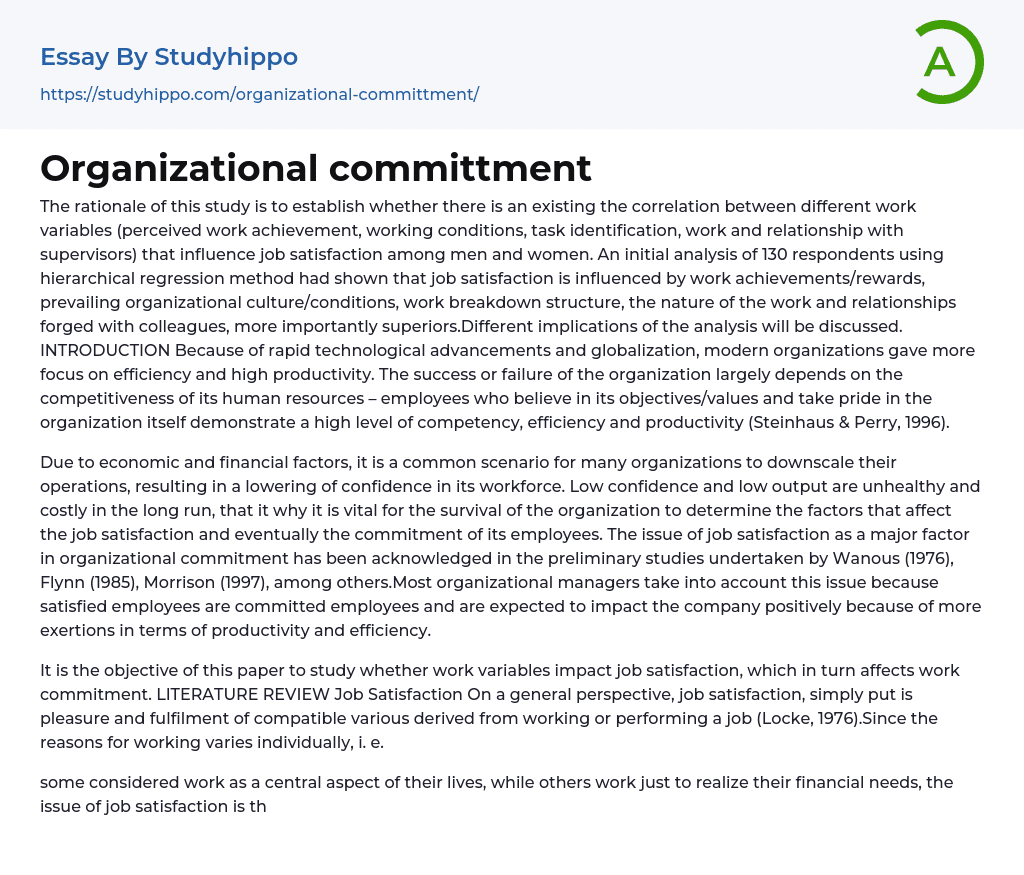The aim of this research is to establish a relationship between different work variables that impact the job satisfaction of both male and female workers. The study examines perceived work accomplishments, working conditions, task identification, and relationships with superiors as potential factors. Using hierarchical regression analysis on 130 participants, the initial findings indicate that several elements such as work rewards/achievements, organizational environment/conditions, job breakdown structure, nature of tasks assigned, and collaboration with colleagues (especially superiors) influence job satisfaction. The implications of these outcomes are further discussed in the analysis section. Additionally, the introduction highlights how technological progress and globalization have elevated efficiency and productivity's importance in modern organizations' success or failure. Competitiveness among human resources has become essential for organizations who require employees to uphold their values/objectives while demonstr
...ating skill proficiency, efficacy and productivity (Steinhaus & Perry, 1996).
In many organizations, downsizing due to economic and financial factors can lead to reduced confidence in the workforce, resulting in decreased output and high costs in the long term. To ensure the survival of the organization, it is important to identify factors that affect employee job satisfaction and commitment. Studies conducted by Wanous (1976), Flynn (1985), Morrison (1997), and others have identified job satisfaction as a major factor in organizational commitment. Organizational managers should prioritize employee satisfaction as it leads to increased commitment and productivity, benefiting the company.
In this paper, we aim to examine the correlation between work-related factors, job satisfaction, and work commitment. According to the literature review, job satisfaction can be described as a general feeling of enjoyment and fulfillment derived from performing job duties or related tasks. This definition was introduced b
Locke (1976) and may differ depending on an individual's motives for seeking employment.
Job satisfaction is a frequently researched topic in organizational behaviour, with some individuals considering work a central aspect of their lives and others purely working for financial needs. According to Mottaz (1987), job satisfaction is the result of one's total job experience, which is determined by the rewards and values apparent in their job. Spector (1997) identifies two aspects or antecedents of job satisfaction: external factors such as interaction and treatment from colleagues and superiors, rewards, promotions, and the nature of the work itself, and individual variables like job expectations, personality traits, need for fulfillment and recognition, personal drives, and experiences (Chapell, 1995).
Job satisfaction and the ability of an individual to meet job requirements are influenced by a combination of antecedents. This, in turn, affects the rewards and promotions an individual receives, including both intrinsic and extrinsic benefits (Kalleberg, 1997). These benefits may encompass task and organizational rewards - those obtained or closely linked to job performance.
The challenge that arises from work is linked to accountability and reliability, among other factors. Organizational rewards are given by the organization as external motivators to encourage membership. These rewards can be tangible, such as salary increases, bonuses, promotions, and job security (Mottaz, 1988).
Organizational commitment can be defined in various ways, but ultimately it pertains to the level of dedication an individual has towards their workplace. Job satisfaction is heavily influenced by two factors: compensation, career advancement opportunities, tenure, and favorable management, all of which contribute to a positive outlook. When employees perceive that their workplace values them and offers appropriate rewards, their job satisfaction
score tends to be higher (Beck, 1990).
Organizational commitment is an attitude measurement that links the worker to an organization (Mowday et al., 1979). According to Meyer & Allen (1991), there are three categories of organizational commitment, with affective commitment being characterized by emotional identification, association, and connection with the organization.
According to Angle and Perry (1983), employees can display two forms of commitment towards their organization: continuance commitment and normative commitment. Continuance commitment is linked to the monetary expense an employee would face if they decided to quit their job, whereas normative commitment stems from a feeling of duty or responsibility towards the organization. Individuals who possess high levels of normative commitment believe that it would be inappropriate for them to leave their current employer. This type of loyalty often results from a mutually beneficial relationship between the employee and the organization in which both parties benefit from rewards or compensation.
Upon joining an organization, employees or individuals are perceived to possess distinct goals, desires, abilities, and knowledge. They anticipate a work setting that enables them to reach their maximum potential. The psychological agreement between the company and its employees is fulfilled by providing this environment and meeting their needs (Kotler, 1993). However, if the organization fails to satisfy the perceived demands and expectations of its members, loyalty will significantly decline (Angle & Perry, 1983).
- Collective Bargaining essays
- Corporate Culture essays
- Hard Work essays
- Job Satisfaction essays
- Organizational Culture essays
- Organizational Structure essays
- Sweatshops essays
- Workforce essays
- Working capital essays
- Working Class essays
- Working Time essays
- Workstation essays
- Bias essays
- Big Five Personality Traits essays
- Body Image essays
- Mind essays
- Motivation essays
- Phobias essays
- Thought essays




